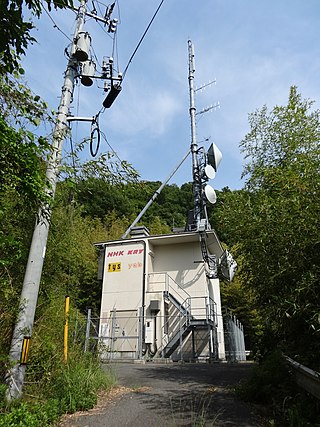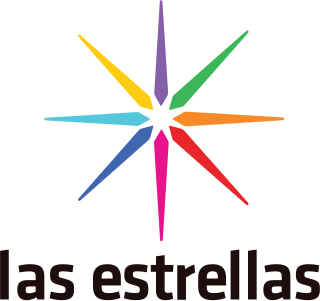
Once is a Mexican educational broadcast television network owned by National Polytechnic Institute. The network's flagship station is XEIPN-TDT channel 11 in Mexico City. It broadcasts across Mexico through nearly 40 TV transmitters and is required carriage on all Mexican cable and satellite providers. The network also operates an international feed which is available in the United States and Venezuela via satellite from DirecTV and CANTV, via online from VEMOX, VIVOplay and also on various cable outlets, on "Latino" or "Spanish" tiers. Most of its programs are also webcast through the Internet, though its programming is not the same as the actual broadcasters or satellite signal.
XETV-TDT is a television station located in Tijuana, Baja California, Mexico, broadcasting programs from Canal 5 and NU9VE. Its terrestrial signal also covers the San Diego, California area across the international border in the United States. The station is owned by Grupo Televisa, and its technical operations and transmitter facilities are located at Mount San Antonio in Tijuana.
XHAS-TDT is a television station in Tijuana, Baja California, Mexico, carrying Canal 66. It is owned by a Mexican company whose largest single investor is Entravision Communications, a U.S.-based operator of radio and television stations with radio and television stations in San Diego, including Univision affiliate KBNT-CD, and a similar interest in Milenio Televisión affiliate XHDTV-TDT. The transmitter is on Mount San Antonio in Tijuana.
XEWT-TDT, virtual channel 12, informally called "Tu Canal", is a Televisa owned-and-operated television station located in Tijuana, Baja California, Mexico. XEWT's over-the-air signal also covers the San Diego, California area across the international border in the United States. XEWT's transmitter is located on Mount San Antonio in Tijuana, with a San Diego bureau on Third Avenue in Chula Vista.
XHBC-TDT is the Televisa Regional television station in Mexicali, Baja California, Mexico. The station can also be seen in the Yuma, Arizona / El Centro, California area.

Canal 6 is a network of Spanish language television stations primarily concentrated in northeastern Mexico and the southwestern United States. The system is part of Grupo Multimedios. The flagship station of Multimedios is XHAW-TDT located in Monterrey, Nuevo León. Programming features locally produced news, sports, children's shows and general mass appeal variety programming. On weekdays, the network produces around twenty hours of live daily programming, with lesser amounts during the weekends and holidays.

XHRIO-TDT was a television station in Matamoros, Tamaulipas, Mexico, which served the Rio Grande Valley area in southern Texas, United States. The station was 98%-owned by Mexican-based Televisora Alco, a 40%-owned subsidiary of station operator Entravision Communications; XHRIO was a sister station to Entravision's duopoly of McAllen-licensed Univision affiliate KNVO and Harlingen-licensed Fox affiliate KFXV, as well as three low-powered stations, all licensed to McAllen: Class A UniMás affiliate KTFV-CD, KMBH-LD, and KCWT-CD. XHRIO-TDT maintained its basic concession-compliant studios in Matamoros, with a second studio facility across the border on North Jackson Road in McAllen housing master control and other internal operations. XHRIO-TDT's transmitter was located near El Control, Tamaulipas.

XHCH-TDT is a television station in Chihuahua, Chihuahua. Broadcasting on virtual channel 1, XHCH is owned by TV Azteca and broadcasts its Azteca Uno network.

XEIMT-TDT, known as Canal 22, is a television station located in Mexico City. Broadcasting on channel 22, XEIMT is owned by Televisión Metropolitana, S.A. de C.V., and operated by the Secretariat of Culture. It is one of Mexico's principal public television stations, with a format emphasizing cultural programming.

A broadcast relay station, also known as a satellite station, relay transmitter, broadcast translator (U.S.), re-broadcaster (Canada), repeater or complementary station (Mexico), is a broadcast transmitter which repeats the signal of a radio or television station to an area not covered by the originating station. It expands the broadcast range of a television or radio station beyond the primary signal's original coverage or improves service in the original coverage area. The stations may be used to create a single-frequency network. They may also be used by an AM or FM radio station to establish a presence on the other band.

Azteca Uno, is a Mexican national broadcast television network owned by TV Azteca, with more than 100 transmitters across the country. Azteca Uno broadcasts on virtual channel 1. Azteca Uno programming is available in Mexico on satellite via Sky and Dish Network, as well as all Mexican cable systems, and some Azteca Uno programming were seen in the United States on Azteca América.

Jalisco TV, virtual channel 17, is the public television network of the Mexican state of Jalisco, operated by the Sistema Jalisciense de Radio y Televisión alongside XEPBGJ-AM and XEJB-FM and broadcasting on transmitters in Guadalajara, Ciudad Guzmán and Puerto Vallarta. Its programming is primarily cultural and educational content.

Las Estrellas is one of the cornerstone networks of TelevisaUnivision, with affiliate stations all over Mexico, flagshipped at XEW-TDT in Mexico City. Many of the programs of Las Estrellas are seen in the United States on Univision, UniMás, and Galavisión.
Televisión Tabasqueña (TVT) is a state-owned public television network serving the Mexican state of Tabasco on three broadcast transmitters. The network is operated by CORAT, the Tabasco Radio and Television Commission, along with La Radio de Tabasco and Mega 94.9. TVT programming primarily consists of cultural and educational content.
Nueve is a Mexican free-to-air television network owned by TelevisaUnivision. The primary station and network namesake is Channel 9 of Mexico City, though the network has nationwide coverage on Televisa stations and some affiliates. Nueve offers a range of general entertainment programs.

Canal 5 is a Mexican free-to-air television network owned by TelevisaUnivision. It traces its origins to the foundation of Channel 5 in Mexico City in 1952. Canal 5's program lineup is generally targeted at a younger audience and includes cartoons, foreign series and movies, along with a limited number of sporting events such as NFL games, boxing, the FIFA World Cup and, historically, the Olympic Games.

KNPG-LD is a low-power television station in St. Joseph, Missouri, United States, affiliated with NBC, The CW Plus and Telemundo. It is owned by the locally based News-Press & Gazette Company (NPG) alongside fellow flagship properties, Fox affiliate KNPN-LD and CBS affiliate KCJO-LD. The three stations share studios at News-Press & Gazette's corporate headquarters on Edmond Street in downtown St. Joseph; KNPG-LD's transmitter is located on South 16th Street, just southeast of downtown.

KCJO-LD is a low-power television station in St. Joseph, Missouri, United States, affiliated with CBS. It is owned by the locally based News-Press & Gazette Company (NPG) alongside fellow flagship outlets, NBC/CW+/Telemundo affiliate KNPG-LD and Fox affiliate KNPN-LD. The three stations share studios at News-Press & Gazette's corporate headquarters on Edmond Street in downtown St. Joseph; KCJO-LD's transmitter is located on South 16th Street, just southeast of downtown.

The Sistema Público de Radiodifusión del Estado Mexicano until 2014, is an independent Mexican government agency. Its mission is to support the development of public broadcasting in the country and expand its coverage. It carries out this goal through ownership of a nationwide network of transmitters and the management of its own public television channel, Canal Catorce. It also owns four radio transmitters.

Canal Catorce is a national public television network of Mexico, operated by the Sistema Público de Radiodifusión del Estado Mexicano (SPR). It began operations in 2012 and is distributed via the SPR's national digital transmitter network, as well as on all cable and satellite providers. It is based in Mexico City.













